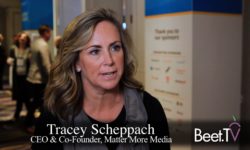SAN FRANCISCO – Matching IRI purchase data for 100+ million households with television ad exposure data from Alphonso’s 34 million household penetration produces “the missing piece” of multi-touch attribution. What finishes the puzzle is 12 million common households and more ways that TV can help to inform digital.
“We’re seeing a full circle here where digital used to influence TV,” says Raghu Kodige, Alphonso’s Chief Product Officer & Co-Founder.
Kodige was one of the speakers at this week’s RampUp 2018 conference by LiveRamp, which drew nearly 3,000 attendees. In this interview with Beet.TV, he details some of the work Alphonso has been doing with IRI, which has the largest database of shopper loyalty data.
To determine how television ads are working, Alphonso used the occasion of the 2018 Super Bowl to do some research based on data from a year earlier leading up to and including Super Bowl 2017. It involved a few different brands that were regular Super Bowl spenders.
For McDonald’s and Dunkin Donuts, Alphonso used location data to track post-ad store traffic. Working with IRI, it was able to attribute TV ad exposure to SKU movement, looking for lift before and after the big football game.
“We were trying to identify what kind of trends you see prior to the Super Bowl and after the Super Bowl. It was pretty exciting,” says Kodige.
One of the things that stood out was the amount of spending by Dunkin Donuts to influence Hispanic audiences on Spanish-language TV networks, particularly in the months ahead of the Super Bowl.
“We saw almost a twelve percent increase in foot traffic to Dunkin Donuts in the three weeks following the Super Bowl, which I thought was pretty significant considering that the Super Bowl reaches such a wide audience.”
Alphonso and IRI announced their data partnership in February 2018.
Alphonso’s research also uncovered insights into things like optimum TV frequency.
The 12 million households common to IRI and Alphonso produce data that facilitates TV tune-in attribution and sales attribution “down to the creative level,” says Kodige. If a brand is testing multiple creative iterations, “within a few weeks we start seeing this data flow into our dashboards with the IRI partnership” so that creative optimization can be done while the campaign is still in-flight, he adds.
The scale is such that it fills the gap in true, multi-touch attribution, according to Kodige. “The missing piece in most of these studies that have happened to date is the absence of large scale TV data.”
This video is part of a series produced in San Francisco at the RampUp 2018 conference. The series is sponsored by Alphonso. For more videos from the series, please visit this page.













































